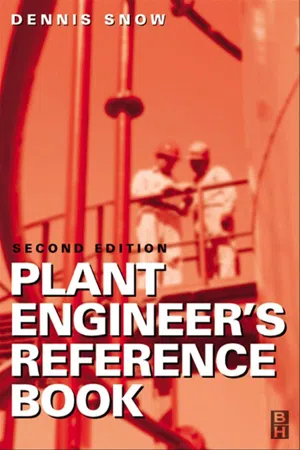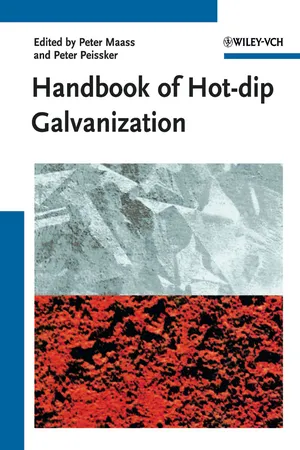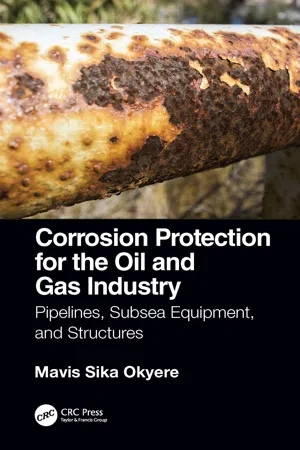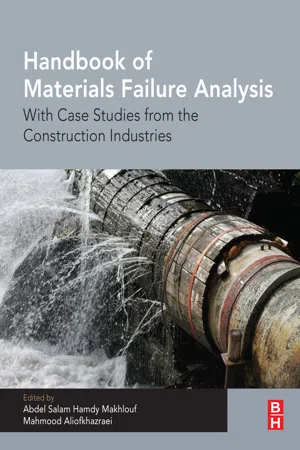Dry Corrosion
Dry corrosion refers to the chemical deterioration of a material due to exposure to the atmosphere without the presence of moisture. This type of corrosion typically occurs in environments with low humidity and can lead to the formation of oxide layers on the surface of the material, compromising its integrity. Preventative measures such as protective coatings or alloy selection are often employed to mitigate dry corrosion.
7 Key excerpts on "Dry Corrosion"
- eBook - ePub
- DENNIS A SNOW(Author)
- 2001(Publication Date)
- Butterworth-Heinemann(Publisher)
...33 Corrosion Michael J Schofield, BSc, MSc, PhD, MIM, CEng, Independent Consultant Contents Corrosion basics Definitions of corrosion Electrochemical corrosion Cracking mechanisms Non-electrochemical corrosion The implications of corrosion Economics Safety Contamination of product Materials selection Sources of information Aqueous systems Non-aqueous processes High-temperature environments Influence of process variables on material selection Influence of external environment Design and corrosion Shape Stress Fabrication techniques Design for inspection Uses and limitations of constructional materials Steels and cast irons Stainless steels Nickel alloys Copper alloys Miscellaneous metallic materials Linings and coatings Specifying materials Compositional aspects Mechanical properties Certification Corrosion-control techniques Painting Cathodic protection Anodic protection Corrosion inhibitors Corrosion monitoring Physical examination Exposure coupons and. electrical resistance probes Electrochemical corrosion monitoring Thin-layer activation 33.1 Corrosion basics 33.1.1 Definitions of corrosion Corrosion is generally taken to be the wastage of a metal by the action of corrosive agents. However, a wider definition is the degradation of a material through contact with its environment. Thus corrosion can include non-metallic materials such as concrete and plastics and mechanisms such as cracking in addition to wastage (i.e. loss of material). This chapter is primarily concerned with metallic corrosion, through a variety of mechanisms. In essence, the corrosion of metals is an electron transfer reaction. An uncharged metal atom loses one or more electrons and becomes a charged metal ion: In an ionizing solvent the metal ion initially goes into solution but may then undergo a secondary reaction, combining with other ions present in the environment to form an insoluble molecular species such as rust or aluminium oxide...
- Shashanka Rajendrachari, Orhan Uzun(Authors)
- 2021(Publication Date)
- Bentham Science Publishers(Publisher)
...Wet corrosion occurs When a metal is in contact with conducting liquid. When two dissimilar metals are partially immersed in a solution. As discussed earlier, at anode, oxidation reaction (loss of electrons) takes place and at cathode, reduction reaction (gain of electrons) takes place. Therefore, anodic metal undergoes deterioration (corrosion) by either dissolving or assuming a combined state. Only anodic materials undergo corrosion but cathodic materials remain uncorroded [ 11 ]. Anodic reaction: During the anodic reaction, the metal undergoes oxidation to form metal ions (M n+) and electrons. Metal ions dissolve in solution or form compounds such as oxide. A cathodic reaction does not affect the cathode; therefore most of the metals cannot be reduced further. At cathode, dissolved constituents in the conducting medium accept the electrons from the anode to form some ions like OH -, O 2-. Fig. (5) shows the impact of wet or electrochemical corrosion [ 11 ]. 13. DIFFERENCES BETWEEN DRY AND WET CORROSION Table 1 Comparision of dry and wet corrosion [6]. Dry Corrosion Wet Corrosion Involves direct attack of atmospheric gases on metal in the absence of moisture liquid phase Involves an electrochemical attack on metals in aqueous environments Less prevalent More prevalent The corrosive media include vapors, gases, etc. The corrosive media occur at liquid (aqueous) phase It is of various types: Oxidation corrosion, corrosion by other gases such as Cl 2, SO 2, H 2 S, NO x and liquid metal corrosion It is of mainly four types: differential metal corrosion, differential aeration corrosion, waterline and pitting corrosion 14. TYPES OF WET OR ELECTROCHEMICAL CORROSION Wet corrosion is broadly classified into: Differential metal corrosion (Galvanic corrosion) Differential aeration corrosion (Concentration cell corrosion) Waterline corrosion Crevice corrosion Pitting corrosion 14.1...
- eBook - ePub
- Peter Maaß, Peter Peißker, Christine Ahner, Peter Maaß, Peter Peißker(Authors)
- 2011(Publication Date)
- Wiley-VCH(Publisher)
...Such processes emanate from the materials’ surfaces and lead to modifications of the material properties or to their destruction. According to DIN EN ISO 8044, corrosion is defined as: “Physical interaction between a metal and its environment which results in changes of the metal’s properties and which may lead to significant functional impairment of the metal, the environment or the technical system of which they form a part.” Note: This interaction is often of an electrochemical nature. From this definition, included in the standard, further terms are derived: Corrosion system: A system consisting of one or several metals and such parts of the environment that affect corrosion. Corrosion phenomenon: Modification in any part of the corrosion system caused by corrosion. Corrosion damage: Corrosion phenomenon causing the impairment of the metal function, of the environment or of the technical system of which they form a part. Corrosion failure: Corrosion damage characterized by the complete loss of operational capability of the technical system. Corrosion resistance: Ability of a metal to maintain operational capability in a given corrosion system. When unalloyed or alloyed steel without corrosion protection is exposed to the atmosphere, the surface will take on a reddish-brown color after a short time. This reddish-brown color indicates rust is forming and the steel is corroding. In a simplified way, the corrosion process of steel progresses and is chemically based on the following equation: (1.1) (1.2) The corrosion processes begins when a corrosive medium acts on a material...
- Zaki Ahmad(Author)
- 2006(Publication Date)
- Butterworth-Heinemann(Publisher)
...Whitney (1903) provided a scientific basis for corrosion control based on electrochemical observation. As early as in eighteenth century it was observed that iron corrodes rapidly in dilute nitric acid but remains unattacked in concentrated nitric acid. Schönbein in 1836 showed that iron could be made passive [2]. It was left to U. R. Evans to provide a modern understanding of the causes and control of corrosion based on his classical electrochemical theory in 1923. Considerable progress towards the modern understanding of corrosion was made by the contributions of Evans [3], Uhlig [4] and Fontana [5]. The above pioneers of modern corrosion have been identified with their well known books in the references given at the end of the chapter. Corrosion laboratories established in M.I.T., USA and University of Cambridge, UK, contributed significantly to the growth and development of corrosion science and technology as a multi disciplinary subject. In recent years, corrosion science and engineering has become an integral part of engineering education globally. 1.2 DEFINITIONS Corrosion is a natural and costly process of destruction like earthquakes, tornados, floods and volcanic eruptions, with one major difference. Whereas we can be only a silent spectator to the above processes of destruction, corrosion can be prevented or at least controlled. Several definitions of corrosion have been given and some of them are reproduced below: (A) Corrosion is the surface wastage that occurs when metals are exposed to reactive environments. (B) Corrosion is the result of interaction between a metal and environments which results in its gradual destruction. (C) Corrosion is an aspect of the decay of materials by chemical or biological agents. (D) Corrosion is an extractive metallurgy in reverse. For instance, iron is made from hematite by heating with carbon. Iron corrodes and reverts to rust, thus completing its life cycle. The hematite and rust have the same composition (Fig...
- eBook - ePub
Corrosion Protection for the Oil and Gas Industry
Pipelines, Subsea Equipment, and Structures
- Mavis Sika Okyere(Author)
- 2019(Publication Date)
- CRC Press(Publisher)
...2 Corrosion Corrosion is the deterioration of a material (usually metal) due to its interaction with the environment. Corrosion is a natural phenomenon, which should not surprise one, but rather should be expected to occur. Metals are high-energy materials which exist because heat energy was added to natural iron ores during the smelting process. Nature, by environmental contact, constantly attacks these high-energy materials and breaks them down to the natural elements from which they were derived. The effect of corrosion on oil and gas pipelines can be catastrophic. The destruction of the metal eventually leads to leakages, which have the potential to cause massive disasters such as fires and explosions. High safety concerns and strict standards applicable to the oil and gas industry mean that constant monitoring is needed to identify the presence and extent of corrosion. 2.1 Basics of Aqueous Metallic Corrosion A corroding system is driven by two spontaneous reactions that take place at the interface between the metal and an aqueous environment. The two simultaneous reactions are the oxidation (anodic) reaction and a reduction (or cathodic reaction). The first reaction is when the chemical species from the aqueous environment remove electrons from the metal; the other is a reaction in which metal surface atoms participate to replenish the electron deficiency. Example of anodic (oxidation, electron donating) reaction: Fe → Fe 2 + + 2 e − metal dissolution Examples of cathodic (reduction, electron accepting) reactions: O 2 + 2 H 2 0 + 4 e − → 40 H − oxygen reduction 2 H + + 2 e − → H 2 hydrogen evolution An important effect is the electron exchange between the two reactions that constitutes an electronic current at the metal surface...
- eBook - ePub
Corrosion of Metallic Heritage Artefacts
Investigation, Conservation and Prediction of Long Term Behaviour
- P Dillmann, G Beranger, P Piccardo, H Matthiessen(Authors)
- 2014(Publication Date)
- Woodhead Publishing(Publisher)
...In this highly complex process, several solid corrosion products of various types and also cycles of wet oxidation followed by dry oxidation are involved. The corrosion product layers are porous and wetted by an aqueous electrolyte during the stages of aqueous oxidation. The severity of this type of corrosion is attributed to the presence of the aqueous electrolyte and also to the participation of the solid corrosion products in the corrosion reactions. Although the phenomenon has been known for many years and the damage has been well predicted by power functions of time for periods of a few tens of years, no mechanistic approach had been undertaken before a recent and original CEA work [ 10 – 14 ] to elaborate a complete mechanistic model aiming at reliable prediction of behaviour over many centuries. Figure 2.3 provides a key for understanding atmospheric corrosion, at least in its general trends. It shows schematically the evolution, during a wet–dry cycle, of the rate of iron loss by oxidation and of the rate of oxygen loss by reduction. Two peaks are evident for the rate of iron consumption, one during the wetting stage and one at the end of the ‘wet’ stage, but only one peak is observed for the consumption of oxygen, associated with the iron peak at the end of the wet stage. This suggests that the oxidant of iron at the end of the wet stage is dissolved oxygen but that another oxidant than oxygen is involved for the oxidation of iron during the wetting stage. This other oxidant was found to be the lepidocrocite γ-FeOOH, which oxidizes metal iron to Fe 2+ cations by reducing itself to a reduced form, γ-Fe.OH.OH. This reduced form is later reoxidized during the drying stage. Thus, lepidocrocite acts as a sort of carrier for oxygen in a cyclic oxidation–reduction process that is the main characteristic of atmospheric corrosion...
- eBook - ePub
- Abdel Salam Hamdy Makhlouf, Mahmood Aliofkhazraei(Authors)
- 2018(Publication Date)
- Butterworth-Heinemann(Publisher)
...The following equation shows the chemical representation of the CO 2 when it mixes with H 2 O. C O 2 + H 2 O → H 2 C O 3 (6.1) 1.1.2. H 2 S corrosion H 2 S is another strong factor seen in the oil and gas industry that is affecting surfaces of metals. H 2 S is produced by the metabolic process of anaerobic bacteria. The bacteria and the sulfate will produce an electrochemical process where the sulfate reduces to corrosive sulfide. H 2 S is a strong gas with high concentrations of hydrogen that diffuses into the metal through the grain boundaries decreasing the ductility of the metal making it brittle and eventually cracking [2]. Fe + H 2 S → Fe S (x) + H 2 (6.2) 1.1.3. O 2 corrosion O 2 is also considered a corrosion promoter because it can mix with other solvents and initiate a corrosion process. Sometimes O 2 forms part of another corrosion product developing synergetic effects with another corrosion processes occurring at the same time. O 2 + 2 H 2 O + 4 e − → 4 O H − (6.3) F e 2 + + 2 O H − → Fe (OH) 2 (x) (6.4) Corrosion rates must be measured at a regular basis as part of safety regulations. Abnormalities in the material, such as the presence of pits and cracks in the bulk material or undercoatings should be avoided. Nondestructive techniques are commonly used for measuring any signals of corrosion on the metal surface. Corrosion types can be identified on time with the assistance of nondestructive techniques. The reasons for corrosion can be challenging requiring intense knowledge and lab activity to conclude the cause of the corrosion that took place. 1.2. Material failure types and mechanism 1.2.1. Pitting corrosion Pitting corrosion is a localized attack where the corrosion dissolute the metal, forming pits or holes. This type of corrosion is dangerous because it is difficult to detect due to the corrosion products that may cover the pits, difficult to design against the formation of pits, as well as to predict when this type of corrosion may occur...






